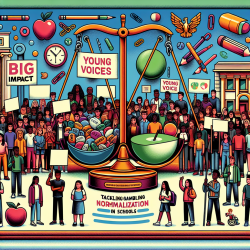Introduction
As a speech-language pathologist passionate about creating positive outcomes for children, it's crucial to leverage research to inform our practices. The recent study titled "Young people in Australia discuss strategies for preventing the normalisation of gambling and reducing gambling harm" provides valuable insights into how young people perceive gambling and what strategies they believe could counter its normalization. This blog will explore how practitioners can integrate these findings into their work, especially in educational settings, to foster healthier environments for children.
Understanding the Problem
The normalization of gambling is a growing concern, particularly as it becomes intertwined with popular cultural activities like sports. The study reveals that young people are not only aware of this issue but have strong opinions on how to address it. They propose five key strategies:
- Reducing the accessibility and availability of gambling products
- Changing gambling infrastructure to mitigate risks
- Untangling the relationship between gambling and sport
- Imposing restrictions on advertising
- Counter-framing commercial messages about gambling
Implementing Research Findings
Practitioners working with children can play a pivotal role in implementing these strategies. Here are some actionable steps:
- Educational Programs: Develop school-based programs that educate students about the risks of gambling, emphasizing the importance of understanding the influence of advertising and the normalization of gambling in sports.
- Community Engagement: Engage with local communities to raise awareness about the impact of gambling and advocate for reduced accessibility to gambling products, especially in areas frequented by young people.
- Policy Advocacy: Work with policymakers to advocate for stricter regulations on gambling advertising and sponsorships in sports, ensuring that young voices are included in these discussions.
- Promote Critical Thinking: Encourage critical thinking among students about the messages they receive from media and advertising, helping them to recognize and question the normalization of gambling.
Encouraging Further Research
While the study provides a strong foundation, further research is needed to explore the effectiveness of these strategies in different contexts. Practitioners can contribute by conducting their own research or collaborating with academic institutions to gather more data on the impact of gambling normalization on young people.
Conclusion
By integrating the insights from this study into our practices, we can better support young people in navigating the challenges posed by the normalization of gambling. As practitioners, it is our responsibility to ensure that children are equipped with the knowledge and skills to make informed decisions and advocate for healthier communities.
To read the original research paper, please follow this link: Young people in Australia discuss strategies for preventing the normalisation of gambling and reducing gambling harm.










